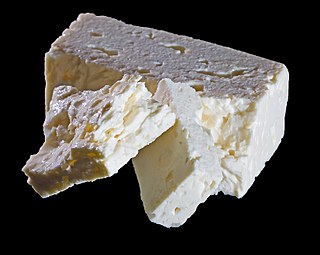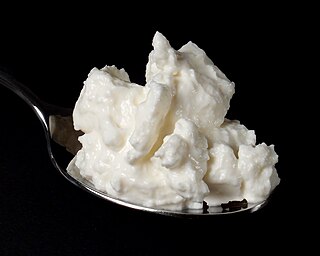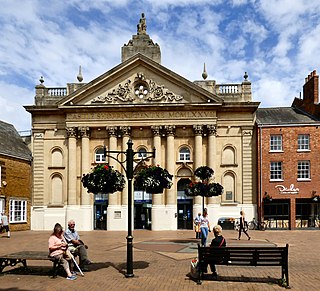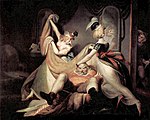
Cottage cheese is a curdled milk product with a mild flavor and a creamy, heterogenous, soupy texture. It is made from skimmed milk by draining curds but retaining some of the whey and keeping the curds loose. An essential step in the manufacturing process distinguishing cottage cheese from other fresh cheeses is the addition of a "dressing" to the curd grains, usually cream, which is mainly responsible for the taste of the product. Cottage cheese is not aged.

Feta is a Greek brined white cheese made from sheep's milk or from a mixture of sheep and goat's milk. It is soft, with small or no holes, a compact touch, few cuts, and no skin. Crumbly with a slightly grainy texture, it is formed into large blocks and aged in brine. Its flavor is tangy and salty, ranging from mild to sharp. Feta is used as a table cheese, in salads such as Greek salad, and in pastries, notably the phyllo-based Greek dishes spanakopita "spinach pie" and tyropita "cheese pie". It is often served with olive oil or olives, and sprinkled with aromatic herbs such as oregano. It can also be served cooked, as part of a sandwich, in omelettes, and many other dishes.

Cheesecake is a dessert made with a soft fresh cheese, eggs, and sugar. It may have a crust or base made from crushed cookies, graham crackers, pastry, or sometimes sponge cake. Cheesecake may be baked or unbaked, and is usually refrigerated.

Shortcake generally refers to a dessert with a crumbly scone-like texture. There are multiple variations of shortcake, most of which are served with fruit and cream. One of the most popular is strawberry shortcake, which is typically served with whipped cream. Other variations common in the UK are blackberry and clotted cream shortcake and lemon berry shortcake, which is served with lemon curd in place of cream.

Cheesemaking is the craft of making cheese. The production of cheese, like many other food preservation processes, allows the nutritional and economic value of a food material, in this case milk, to be preserved in concentrated form. Cheesemaking allows the production of the cheese with diverse flavors and consistencies.
Hoop cheese is a traditional cow's milk cheese that was common in the Southern United States from the early to mid 1900s. It is still available today, although it is much less common. It is a simple cheese prepared by separating the whey from curds. Today, the American Dairy Association has no criteria in place to classify hoop cheese, although it has sometimes been referred to as a type of pot cheese.

Blue cheese is any of a wide range of cheeses made with the addition of cultures of edible molds, which create blue-green spots or veins through the cheese. Blue cheeses vary in taste from very mild to strong, and from slightly sweet to salty or sharp; in colour from pale to dark; and in consistency from liquid or very soft to firm or hard. They may have a distinctive smell, either from the mold or from various specially cultivated bacteria such as Brevibacterium linens.

Paneer, also known as ponir, is a fresh acid-set cheese common in the cuisine of the Indian subcontinent made from full-fat buffalo milk or cow milk. It is a non-aged, non-melting soft cheese made by curdling milk with a fruit- or vegetable-derived acid, such as lemon juice.

Kugel is a baked casserole, most commonly made from lokshen or potato. It is a traditional Ashkenazi Jewish dish, often served on Shabbat and Jewish holidays. American Jews also serve it for Thanksgiving dinner.
Latvian cuisine typically consists of agricultural products, with meat featuring in most main meal dishes. Fish is commonly consumed due to Latvia's location on the eastern shore of the Baltic Sea.

Boxty is a traditional Irish potato pancake. The dish is mostly associated with the north midlands, north Connacht and southern Ulster, in particular the counties of Leitrim, Mayo, Sligo, Fermanagh, Longford, and Cavan. There are many recipes but all contain finely grated, raw potatoes and all are served fried.

Tibetan cuisine includes the culinary traditions and practices of the Tibetan people in the Tibet region. The cuisine reflects the Tibetan landscape of mountains and plateaus and includes influences from neighbors. It is known for its use of noodles, goat, yak, mutton, dumplings, cheese, butter, yogurt, and soups. Vegetarianism has been debated by religious practitioners since the 11th century but is not prevalent due to the difficulty of growing vegetables, and cultural traditions promoting consumption of meat.

A Banbury cake is a spiced, oval-shaped, currant-filled pastry. Since the mid-19th century, Banbury cakes have grown increasingly similar to Eccles cakes; but the earlier versions were quite different to the modern pastry. Besides currants, the filling typically includes mixed peel, brown sugar, rum, and nutmeg. Banbury cakes are traditionally enjoyed with afternoon tea.

Cheese is a dairy product produced in a range of flavors, textures, and forms by coagulation of the milk protein casein. It comprises proteins and fat from milk. During production, milk is usually acidified and either the enzymes of rennet or bacterial enzymes with similar activity are added to cause the casein to coagulate. The solid curds are then separated from the liquid whey and pressed into finished cheese. Some cheeses have aromatic molds on the rind, the outer layer, or throughout.

Quark or quarg is a type of fresh dairy product made from milk. The milk is soured, usually by adding lactic acid bacteria cultures, and strained once the desired curdling is achieved. It can be classified as fresh acid-set cheese. Traditional quark can be made without rennet, but in modern dairies small quantities of rennet are typically added. It is soft, white and unaged, and usually has no salt added.

The Cornhill Corn Exchange was a commercial building in the Market Place, Banbury, Oxfordshire, England. The façade of the building, which has been preserved and now forms an entrance to a shopping centre, is a Grade II listed building.















